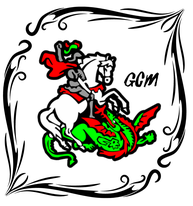Milton Keynes - Disappointment is a reminder that growth lies in resilience and the courage to try again!
Motto: It may startle some political economists to talk of commencing the building of new cities ... planned as cities from their first foundation, and not mere small towns and villages. ... A time will arrive when something of this sort must be done ... England cannot escape from the alternative of new city building.
— T. J. Maslen, 1843
#MayInLeo - today we talk about urban planning.

I bet not many of you know about the story of the English town called Milton Keynes. This is one of the greatest urban planning performances, starting in the 1960s-1970s, with the need to create new homes to relieve the housing congestion in London. This led to the creation of the Milton Keynes Development Corporation (MKDC), a development corporation operating from 1967 to 1992 to oversee the planning and early development of Milton Keynes, then a planned new town midway between London and Birmingham.
The idea was to build a whole new town from scratch, with all the advantages, and none of the problems that earlier new towns, that developed organically, over time, have. We had some big-time architects and engineers involved in the project, I can mention Walter Ismay, Richard Llewellyn Davies (great at designing hospitals, did The Times offices building too), Fred Roche (did Butler's Wharf and Michelin House in London), Walter Bor (notable work in developing cities as Bogota in Colombia, Nicosia in Cyprus and Shenzen in China), John de Monchaux and Sue de Monchaux, Frank Henshaw and Sir Henry Chilver (this one did more politics and less engineering). MKDC stopped its activity in 1992, as the project was considered finished.
As you see, the best minds that the UK had at that time, joined together to build the perfect town, and Milton Keynes was the result. On that date, the area within the designated area was home to some 40,000 people in the existing villages. The new city would have a direct motorway (the M1) and rail link (the West Coast Main Line) with the capital city, London, and Birmingham; both 50–60 miles away. What could go wrong? They wanted this one to be a modern interpretation of the garden city movement, with no building higher than the tallest tree, three storyes building being the height limit, a daring idea, at a time when the big building blocks started to dominate the horizon of London and the other major cities.
To deal with the issue of being stuck in traffic, a problem unsolved in most of the traditional towns and cities, they established a grid of distributor roads about 1 kilometre (0.62 mi) between edges, leaving the spaces between to develop more organically and an extensive network of shared paths for leisure cyclists and pedestrians crossing through and between them. The biggest SIM-City experiment ever started, and the amenities were supposed to be something spectacular too, as they built a 1,400-seat theatre, a municipal art gallery, two multiplex cinemas, a central church, a 400-seat concert hall, a teaching hospital, a 30,500-seat football stadium, an indoor ski-slope, a 65,000-capacity open-air concert venue and the Milton Keynes Mall. Truth to be told, even now, with so many shops closed everywhere, the Mall is still a good place to go shopping, and thanks to the £2 bus ticket initiative (pay £2 and go anywhere you want with the bus), I did visit MK Mall more often lately.
Even now, Milton Keynes is an ideal place for all types of entrepreneurs, as the UK's fifth-highest number of business startups per capita (but equally the 5th place for business failures). Even if it started as a town, and failed to achieve city status after competing for it in 2000, 2002 and 2012, Milton Keynes finally became a city in 2022.
As for the green aspect, we have many linear parks (parks being longer than wide) and millions of trees were planted all over the town, with an astounding 25% of Milton Keynes town surface being parks, lakes and green spaces. The Open University is here, some units from the University of Bedfordshire too, and plenty of schools.
Still, there are some issues, like social inequality, with the city having nine "lower super output areas" that are in England's 10% most deprived, but also had twelve 'lower super output areas' in England's 10% least deprived. Homelessness is rampant in Milton Keynes too. In the industrial side of the city, quite a few projects were abandoned, we have empty and derelict buildings and streets that look like part of some post-apocalyptic movie. A rise in violent crimes number, the high cost of housing, insecure and low-paid jobs, low levels of skills, inadequate benefits, high transport and childcare costs, all of these are keeping people away from what was once a unique project, with hopes to provide solutions for a cramped future.
All the best,
George

Why not...
...have fun and win rewards on my favourite blockchain games (Splinterlands- Hearthstone-like card game) (Mobox - GamiFI NFT platform) (Upland - real-life virtual land) (Holozing - Pokemon-like game)and (Rising Star - Music creators game).
...Get ETH while writing on the Publish0x blog, using the Presearch search engine to maximize your income with PRE tokens. Use Torum instead of Twitter. I am also writing for crypto on Read.cash and Hive.
Posted Using InLeo Alpha
What do you think about your own town/city? Advantages and disadvantages?
Congratulations @heruvim1978! You have completed the following achievement on the Hive blockchain And have been rewarded with New badge(s)
Your next target is to reach 47000 upvotes.
You can view your badges on your board and compare yourself to others in the Ranking
If you no longer want to receive notifications, reply to this comment with the word
STOP